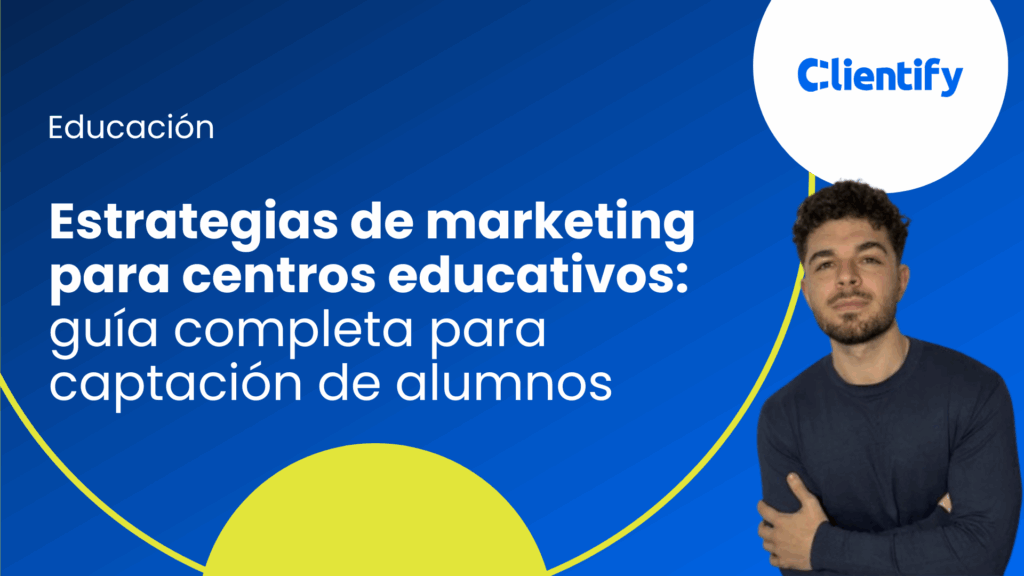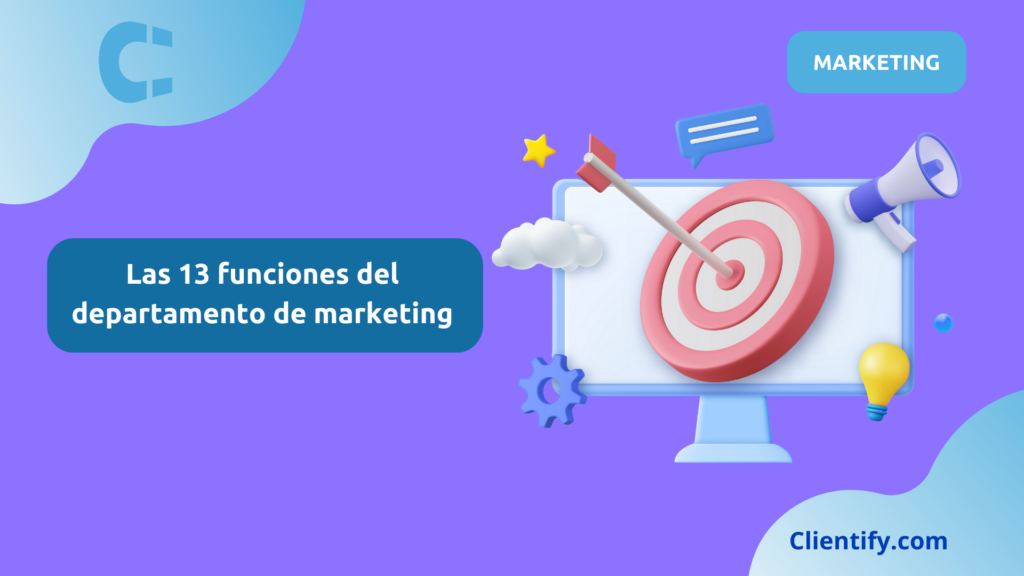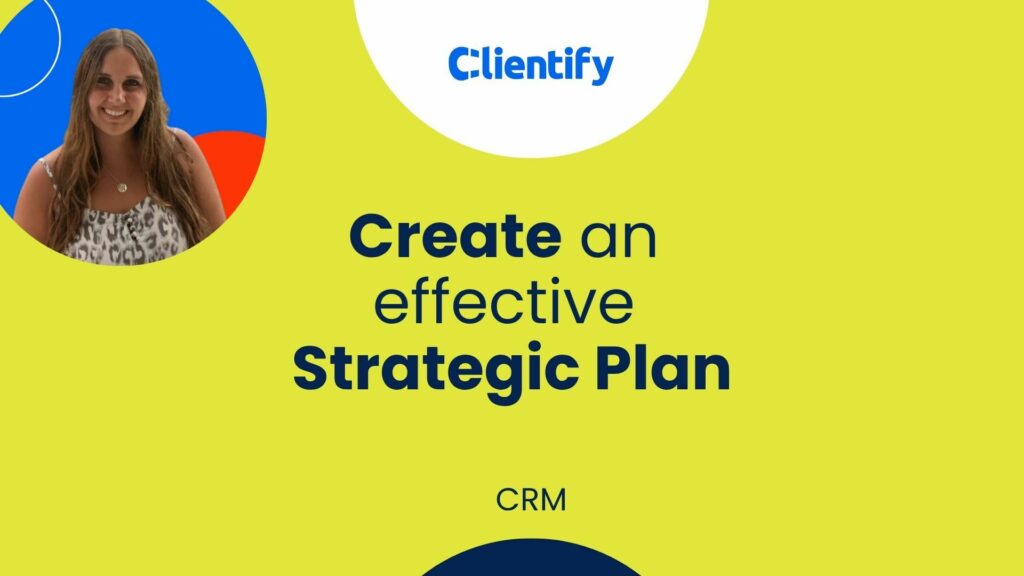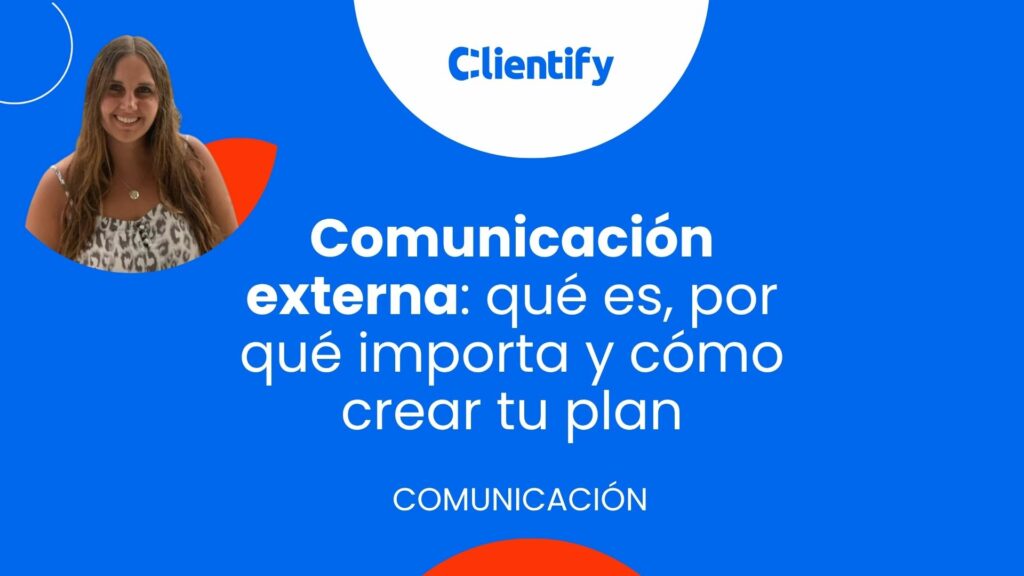Attracting students today is not a matter of placing an ad on Facebook and, hala, waiting for enrollment.
If you’re looking for school marketing strategies to attract new students that work, you need a little more than intuition.
Fortunately or unfortunately, it’s time to get out the whiteboard and make a plan.
And even more so in the education sector: it is becoming more and more contentious, students compare, parents give their opinions and decision cycles take forever.
If your center does not have a clear process, you are not going to eat a donut: the competition will take it away.
You have to design a marketing strategy for schools that makes sense and then execute it the same way every time: attract, respond quickly, segment, nurture prospects until they are ready and close enrollment.
At Clientify we work with centers like yours every week and have spoken to some of them to see what works and what doesn’t in recruitment and admissions.
Here’s your guide to getting your enrollment started and having a student recruitment strategy that works.
Key ideas (TL;DR)
- Define your ideal student
- Multiply entry points
- Responds in seconds
- Segment well
- Nurtures and qualifies leads
- Easy registration and payment
- Tools
Define your ideal student (buyer persona)
Let’s start with the basics, before thinking about ads or super creative campaigns you have to be very clear about who you want to attract.
If you don’t know who your ideal student is, you will spend time, money and energy on people who were never going to enroll.
A buyer persona is basically a card that tells you:
- what are you looking for
- what objections do you have
- who decides
- what budget do you manage
- and at what time you are planning to enroll.
With that, you can write messages and value propositions that answer their questions and campaigns that target well from the start.
It is not the same for a student looking for a master’s degree to move up the career ladder as it is for a young person who wants a quick language course, or a company that finances a vocational training program for its employees.
Each one has different motivations, objections and decision makers…. If you put them all in the same bag and send the same message to all… I’m telling you, it’s not going to work.
For example, a buyer persona file for a master’s degree in finance:

Objectives, objections and decision makers
Your buyer persona or ideal student is not “young people from 18 to 24” or “professionals looking for a master’s degree”, give a little more love to this, you have to go finer:
- Typical objectives: improve employability, recycle, certify knowledge, combine studies with work or learn a language to open doors.
- Frequent objections: price, time, prestige of the degree, fear of not finishing it or doubts about job opportunities.
- Key decision-makers: it can be the student himself, the parents/guardians or even the funding company. Depending on who decides, the message changes: to a parent you talk about safety, to a professional about ROI, to HR about efficiency. HR about efficiency.
Tip: include in your forms fields such as main motivation, who finances and when you want to start. With these three answers you can segment your campaigns much better.
Message map and value proposition by program
Okay, you have defined your ideal student, now it’s time to convert it into messages.
Here it works very well to make a table with this scheme:
Program → Pain/target → Test of value → Message → CTA.
Examples:
- Master in Data:
“I want to change role and earn more” → project with company + job board → “Leave with proven experience and a new job” → schedule a call.
- Portuguese B1 course
“I have meetings with Brazil and I don’t know anything” → small groups + official certificate → “Practical classes, 0 grammar” → try a class for free.
- FP Dual:
“I need real internships” → agreements with companies, 80% job placement → “Study and work from month 2” → book interview.
Try it, do just this with your priority programs.
Design and analyze your recruitment methods and conversion channels.
Having a clear idea of who your ideal student is is all well and good, but it is of little use if you don’t have entry doors.
And be careful, it’s not about putting a crappy form hidden in the web: in educational marketing, each channel must be designed so that the interested student leaves his data in the simplest possible way and you know where he comes from.
The good thing is that today you can combine landings, pop-ups, network ads, chatbots, etc. without a lot of work or “specialists” who charge you for breathing, even my mother knows how to do it, I’m not kidding.
But the important thing is not just to “have” them, but to measure which ones work and which ones do not.
Because a channel that attracts a lot but doesn’t convert is a budget drain.
Here are the basics you need to keep track of:
We are in the era of Artificial Intelligence, it is used for EVERYTHING, except for writing this post (a little bit yes :D), use it with sense, that’s what it is for:
1- Dedicated Landing pages
In case you get lost in the concepts, landing pages are web pages made just to recruit students for a specific program (more or less).
Do not put seven courses on the same page.
For each course or program, create a unique, well-structured landing page with a value proposition and a call to action (“I want more info” or “sign up”).
Nowadays you can create landing pages in minutes with WordPress or an AI landings builder. What I would do is to take advantage of the 14 days you have for free to use Clientify, enter the AI landings builder and as it is, you can tell it:
“I want an eye-catching, creative and functional landing page for a “Master of assembling Legos”, our ideal client is…”
Look, while I was writing this I tried it, 10 seconds, I swear I didn’t take longer.
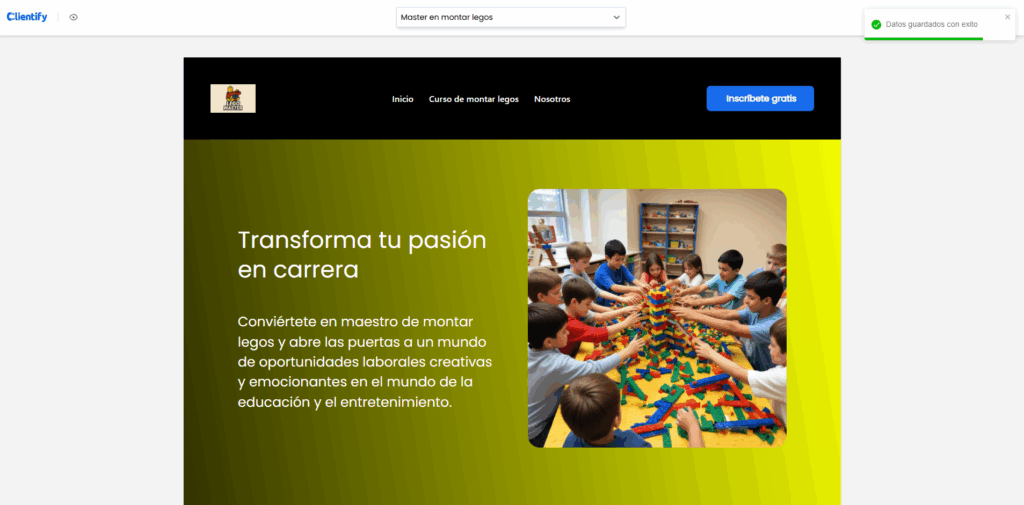
2- Short and meaningful forms
Ask for the minimum (name, email, program of interest) and add smart fields.
Example: if you check “master’s degree”, questions about modality or budget are displayed; if you check “short course”, timetables are displayed.
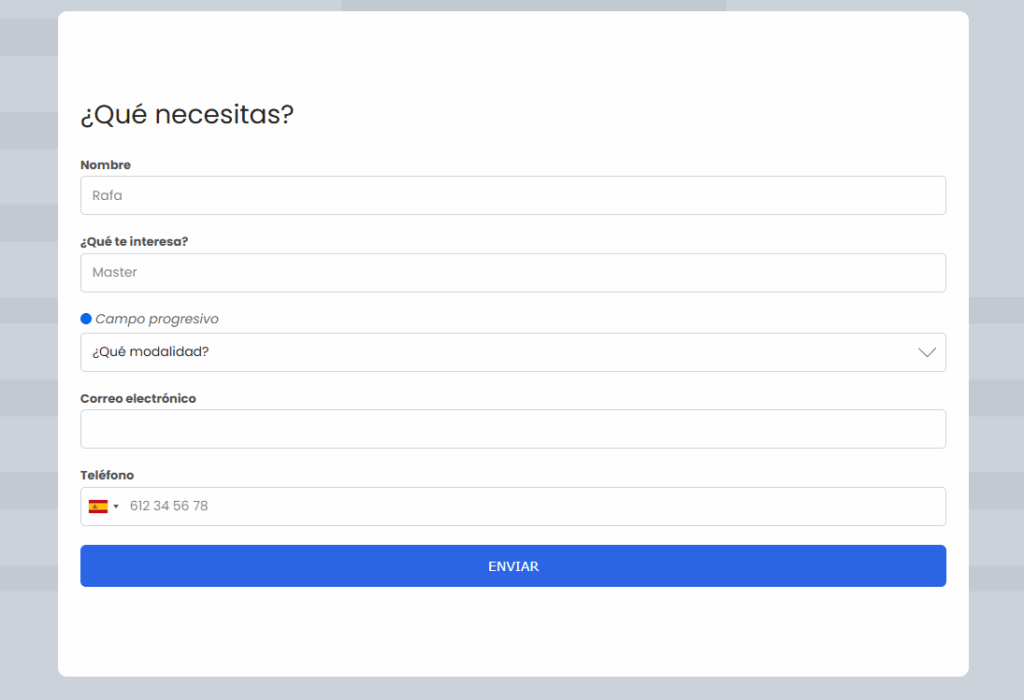
3- Intelligent pop-ups
Do not abuse.
Only show them when there is a clear intention, for example when leaving the page.
And always with something of value: download the syllabus, sign up for a demo or view available scholarships.
4- AI Chatbots
A basic bot only collects data and responds in a very limited way; an AI chatbot that is trained in your center, answers real questions in seconds (“Are there places available?”, “Price?”, “Can I do it online?”, “What courses are there?”) and then guides the lead to leave their data or request a call.
Here is an example of a WhatsApp AI chatbot that we have trained for a training school:
(This chatbot is just a sample/test)
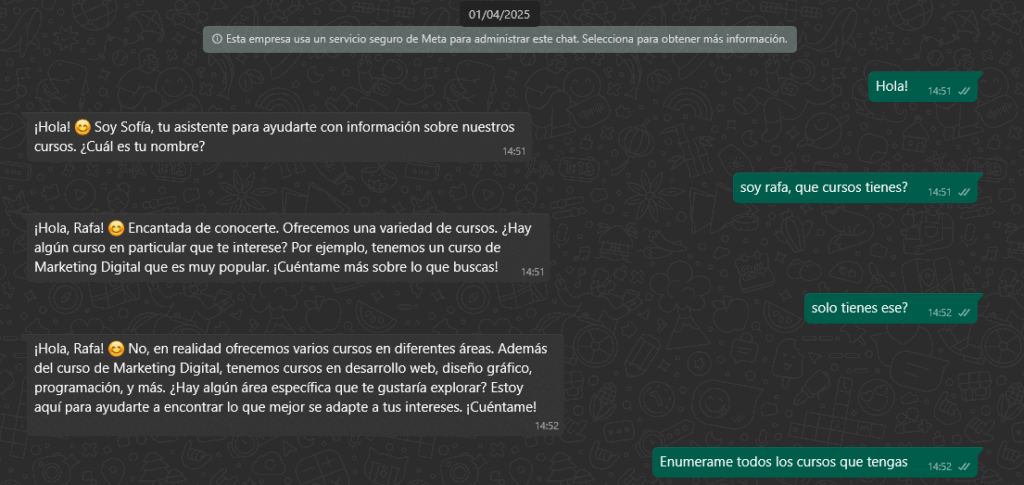
5- Lead magnets and micro-conversions
You can’t expect everyone who enters your website to convert instantly.
Some (most) need to “warm up” or, as they say in marketing jargon, nourish themselves.
Provide value before you ask for it. Examples in the education sector:
- First class free → the best way to get them to try it and get hooked.
- Downloadable syllabus or index → so they compare with other centers and see that you are serious about it.
- Practical guides → e.g. “How to choose the right master’s degree for your career” or “5 keys to pass a B2 in less than 6 months”.
- Grants or financing → the number one magnet: if someone sees that they can pay in installments or with help, they leave the data in two seconds.
They are “excuses” to start the relationship with your next student, the more mini-conversion points you have, the more students come in.
6- Traceability of campaigns and sources
If you don’t know where each lead comes from, you’re going in blind.
And beware, at the beginning it is normal: you launch campaigns and think “as long as contacts come in, fine”.
But seriously, if you don’t measure, you’ll end up throwing money away on channels that don’t even bring you half a student.
Here what you have to do is simple:
- Use UTM in all your links → they are tags that you put in the links of your ads, networks or emails, they are useful to know later if the lead came from Facebook Ads, from a post on Instagram or from a newsletter.
- Synchronize with your CRM → each lead must have its source marked: SEO, SEM, social networks, referral… The important thing is that it is recorded without you having to be with an Excel.
- Close the circle → it’s not enough to know which channel brings leads, see which channel brings real enrollments, maybe your TikTok campaign fills your database with curious kids, but none of them pay. Better to invest in the channel that does convert into students.
Tip: set up a simple dashboard (it can be your own CRM) where you can see at a glance: visits, leads and conversion to enrollment.
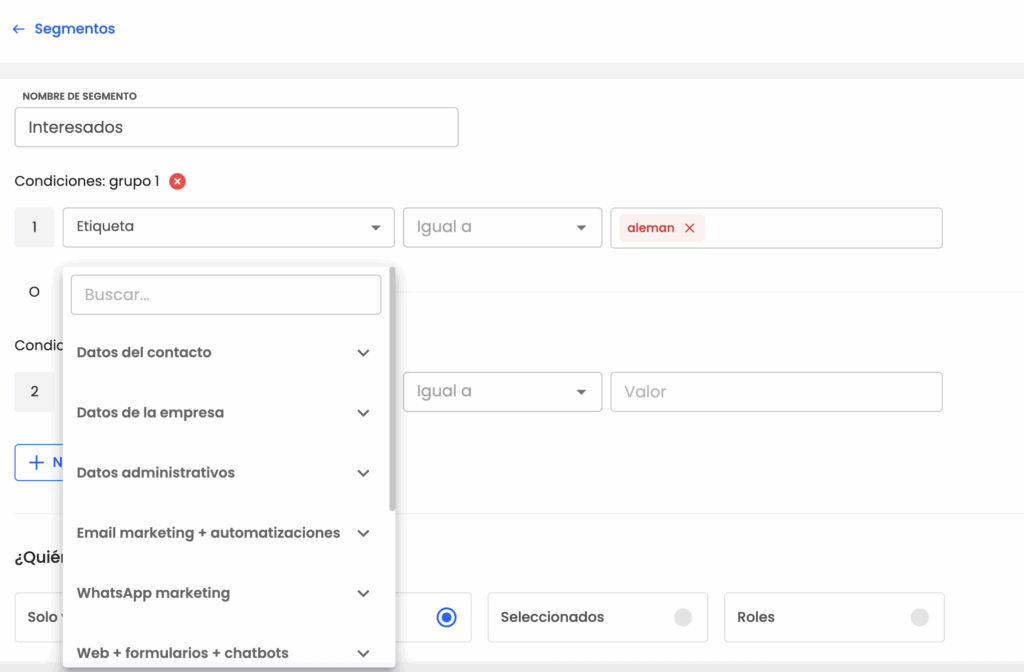
Online acquisition channels in educational centers – SEO, networks and SEM
Having landings, forms and chatbots is all well and good, but if no one gets there, it doesn’t matter how nice they are and how well put together they are.
Let’s touch on your acquisition channels, the online presence: that they find you when they search, that they see you where they hang out and that you show up when they are already comparing options.
You don’t need to have an army of twenty marketing geeks: with a little order and desire you can work SEO, social networks and paid campaigns (SEM) to attract quality traffic to your website.
Shall we get down to business?
SEO for schools, make yourself visible to your future students
My favorite channel, SEO.
In education, most students start their search on Google.
Does your school focus on algebra? Position for that keyword and some related ones:
- Algebra course
- Master on algebra
- How to learn algebra
- The 5 keys to algebra…
Something like that, I have no idea about algebra, but you get my drift.
If someone searches for “The best algebra courses” and you are not there, you do not exist for that potential student, it is not that “you do not appear in those searches”, it is that your competitors who are positioned are the ones who get those registrations.
If you do it right, up to 33% of traffic in the education sector can come from organic search for virtually free.
But beware, it’s not just Google anymore.
More and more people are asking an AI directly what to study or where to enroll.
That means that your website has to be optimized for that as well:
- Answer doubts in clear and short sentences (AIs take that text to give the answer).
- Add a Frequently Asked Questions section with 50-80 word answers, as if you were responding to a student via WhatsApp.
- Use natural language: “How much does it cost?”, “What are the outlets?”, “Can it be paid in installments?”.
If you do it right, you also show up when someone asks ChatGPT or Perplexity. That’s SEO for AI.
The social networks of an educational center
Social networks are not for everyone, or rather, not all.
To make my point, it’s not going to do you any good to be on every social network there is if your target student isn’t there.
Your head has to be in two well-chosen channels where your buyer persona is:
- Instagram and TikTok have good visual showcases, plus, people use their search engines A LOT.
- LinkedIn works great for masters and professional programs.
- Facebook for parents of children and teenagers, little else.
A useful note: in the education sector, Instagram is still powerful. Institutions are getting an average engagement rate of 4.2%, while Reels is around 3.1%. That’s light years ahead of any post on Facebook or Twitter.
SEM for admissions: pay to be where it matters
There is no mystery here: if you want fast results, you have to pay the cash register.
With SEM (paid campaigns on Google, Meta or LinkedIn) you can get in front just when a student is looking for options or when their parent is comparing.
- Google Ads: is the king when someone searches for “English course B2 in Seville” or “master in online marketing price”. If you are not there with your ad, the competition appears and takes the enrollment.
- Social Ads: Instagram and Facebook Ads work because you can segment by age, interests, LinkedIn Ads, on the other hand, are a great fit with masters and executive programs.
Fact to convince your rector: in education, the average cost per lead in paid campaigns is usually between 40 and 60 €, depending on the program and the area(Wordstream, benchmark of Ads in education).
Expensive? It depends: if that lead ends up paying for a €5,000 master’s degree, the investment pays for itself.
Advice from our clients (schools, universities, educational centers)….:
Never send the ad to the home page, the click has to land on the landing page of the program with its info and form.
Automates first contact (speed-to-lead)
If someone leaves you their data and it takes a day to receive a response, you lose them.
In education, interest is hot but cools quickly: studies say that responding in the first 5 minutes multiplies by 21 the chances of talking to that student seriously.
But let’s be realistic… Who’s watching 24/7?
There is a very simple solution, automation.
You can have a simple flow that, as soon as the lead arrives, sends a booking email, if a day goes by and he/she doesn’t open it, a WhatsApp is sent to make a push, if he/she opens it, the consultant in charge of the lead is notified.
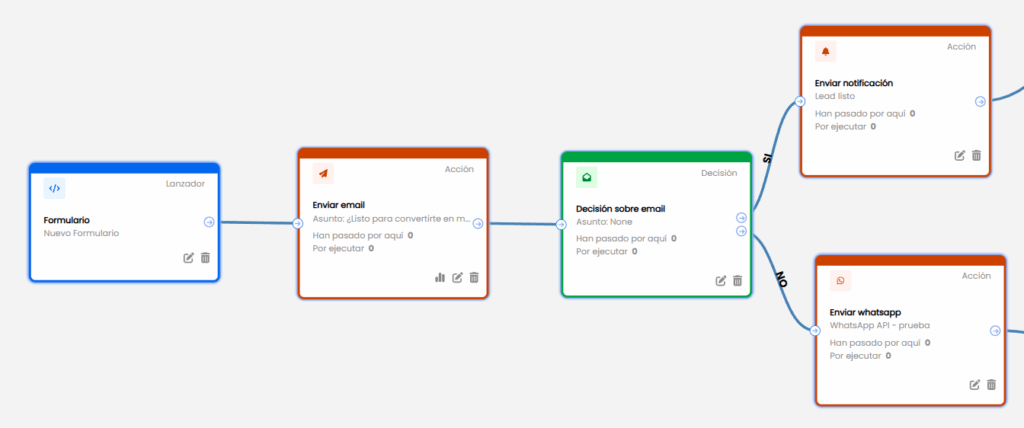
Segment to communicate better
As Julius Caesar said, divide and conquer.
If you send the same message to all your leads, half of them will ignore it and the other half will unsubscribe.
This is what we were talking about before, a person looking for an executive master’s degree is not the same as someone looking for an evening language course.
If you mix messages, you lose credibility, relevance and leads.
Basic segmentation criteria
The minimum you must differentiate in your CRM:
- Program of interest: master’s degree, vocational training, language course…
- Student level: beginner, advanced, professional.
- Location / modality: online, face-to-face, hybrid.
- Decision time: want to start now, in 3 months, or “I’m thinking about it”.
With these fields you can create segments that update themselves.
If a lead comes in with “FP” and “presencial en Madrid”, you already have the label in place to talk to them with important messages.
Examples of segmented campaigns that convert
- Segment: Online master’s degree → Emails with job opportunities + testimonials from students who changed jobs.
- Segment: basic language courses → WhatsApp with free class trial + timetable calendar.
- Segment: Parents interested in FP → Facebook campaign highlighting scholarships and internships in companies.
- Segment: Leads that are still cold → Educational email series: guides, comparatives, success stories.
The goal is to send the right message to the right person at the right time, which multiplies the open rate, clicks and, above all, registrations.
Nurture and qualify leads before selling
Not every lead that enters your CRM is ready to pull out their card and pay.
Some need more information, some need time, and many just a little trust.
If you treat them all the same, you will put too much pressure on some and leave others cold.
The “trick” is to nurture them with content that is important to them and qualify them with lead scoring to know who is ready to talk to a consultant and who needs a little bit of cooking (not literally, you know what I mean).
Nurturing flows (email, WhatsApp, content)
And to “nurture” these leads so that they go from being cold to hot and ready to buy, we use a nurturing strategy: automatic messages that accompany the student until he or she is ready to decide.
Imagine you manage a language school and a contact downloads your B2 English course syllabus:
- Email 1 (day 0): “Thank you for your interest, here is the complete syllabus“, with a video of a teacher explaining what a class is like.
- Email 2 (day 3): “5 tricks to pass the B2 without dying trying”, valuable content, no direct selling.
- WhatsApp (day 5): “Hi Ana, I saw that you downloaded the syllabus. I’m passing you the timetables for this quarter and an early registration promotion”.
Another example: a lead arrives on the page of a PF in Administration and asks for more information:
- Email 1 (automatic): file with internships in collaborating companies.
- Email 2 (3 days later): real case of a student who got a job before finishing vocational training.
- WhatsApp (1 week later): “You still have time to sign up for the September call, do you want to reserve a place?”.
These flows are not improvised on the fly or done manually: they are designed once and triggered automatically according to the learner’s action (download, visit, click).
And, seriously, thanks to Clientify’s automatic flows it’s super simple, check it out:

Lead scoring and intent signals
If lead nurturing is to move from a cold lead to a hot lead, lead scoring is the “thermometer” that indicates how hot the potential student is.
Example 1: Language Academy
- Download the B2 English course syllabus → +10 points.
- Open the email with “5 tricks to pass the B2” → +5 points.
- Click on the WhatsApp with schedules and prices → +15 points.
- Back to the enrollment page in less than a week → +20 points.
With 50 points accumulated (or whatever you assign to it), the CRM already marks it as a hot lead: it is time for an advisor to write to it personally and close the enrollment or execute an automation.
“As soon as the lead reaches 50 points a flow with email and a payment link is triggered.”
Example 2: VET in Administration
- Fill in the interest form → +10 points.
- Download the internship guide → +15 points.
- Attend an open house webinar → +20 points.
- Ask about financing or tuition terms → +30 points.
When you pass 60 points, you know that student is one step away from deciding.
If a counselor doesn’t call you that same week, you may end up at another center.
The value of scoring is that you don’t have to decide by eye: the CRM assigns points according to the student’s behavior and when he/she crosses the threshold you define (e.g. 40, 50, 60), the alert is triggered.
When to pass a lead to sales
This is where many centers mess up: either they pass the leads too early and burn them, or too late and lose them to the competition.
The art is in detecting the right point at which a lead is ready to talk to an advisor.
Example 1: Language Academy
If the lead downloads the English B2 syllabus and the next day a consultant calls him, he will most likely think “I just wanted to look at it” and leave you hanging. That lead is still frozen.
But if you have already opened several emails, clicked on the schedules and returned to the enrollment page, you are showing clear intent.
This is the time for an advisor to contact you by WhatsApp or call to resolve doubts and close enrollment.
Example 2: VET in Administration
If a student only filled out the initial form and already receives an aggressive sales call, he feels pressured and leaves.
On the other hand, if he already downloaded the practice guide, attended a webinar and asked for funding, you have all the signs that he’s ready.
There a counselor should come into action to confirm deadlines, scholarships and accompany you to enrollment.
The rule is simple: not before and not after. Too early you burn the lead, too late you give it away to the competition.
Facilitates enrollment and payment
Getting this far is already an achievement: the student knows you, you know they are interested in the program, they have left you their contact information and they have even talked to your team.
But if you get in the way at the last step, your license plate will fall off.
In education, many times you don’t lose students because they don’t like your course, but becausethe enrollment process is a mess: a lot of bureaucracy, inflexible payments or mandatory procedures that are a pain.
Flexible payment options
In a language school, imagine that you offer a single lump sum of 900 €.
For many, it is too much all at once, even if they can afford it.
Now the model changes: initial registration fee of 100 € and then 5 installments of 160 €.
Come on, now it becomes accessible.
The same thing happens with masters: nobody wants to pay 5,000 € at once, but with installments or financing it is no longer a wall.
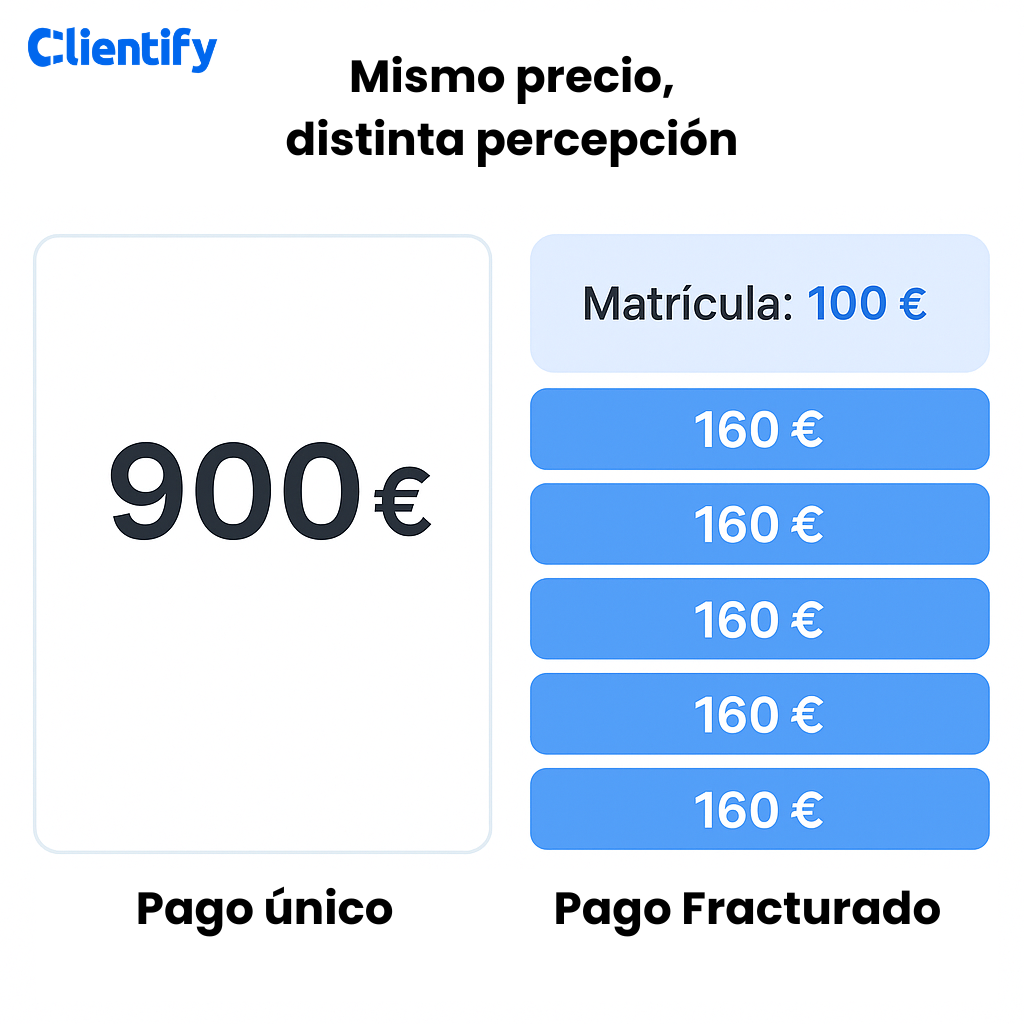
Scholarships and grants as a recruitment lever
In a Management VET, if you highlight from the first call that there are partial scholarships or funding agreements, the conversation changes.
The student or their parents stop thinking “I don’t know if I can afford it” to “well, maybe I can”.
Showing scholarships on the web, in the email or even in the automatic WhatsApp makes many leads who were hesitating take the step of filling out the form.
A headache-free enrollment experience
This is where digital comes in.
If to enroll a student has to print a PDF, sign it with a pen and scan it, you lose points.
Today you can solve it with an online form, electronic signature and one-click payment link.
For example: a student who is determined to enter a master’s program, fills out the form on your website, signs on his cell phone and pays the initial tuition in 3 minutes.
No need to send paperwork or wait for eternal confirmations.
Well, here we go, another student with a license plate.
Marketing strategies for educational centers
So far, we have talked about acquisition tactics: how to attract leads, nurture them, automate, segment…
Okay, cool, but that’s only part of it.
What makes a center really stand out is having a comprehensive educational marketing strategy: a framework that brings in new students, positions your institution, builds trust with families and generates a reputation that works for you.
Positioning and value proposition of the center
This is where many centers skate: they say the same thing as everyone else. “Quality training”, “expert teachers”, “innovative programs”.
Sound familiar? Maybe you’ve read it in 12,482 other centers.
Positioning is not that, ask yourself:
- What makes you different from other centers in your city or sector?
- What results can your students expect?
- What story do you want them to tell about you after coming through your center?
For example, if your forte is employability, your value proposition is not “quality classes”, it is “8 out of 10 students get jobs before finishing the program”.
If languages are your thing, instead of saying “dynamic classes”, say “you will speak with a native speaker from day one”.
Sounds different, huh?
Beyond that, positioning is worked with data, testimonials and a clear narrative that is then repeated in all your channels, from a master’s landing page to a TikTok reel.
Content and communication plan with families
Content isn’t just for the blog or LinkedIn, it’s also how you maintain the relationship with those who decide to sign up (or pay) in the end: the students and their families.
If your center only appears in their lives when it’s time to pay their tuition, you are losing opportunities to build loyalty, resolve doubts and gain their trust.
Every content plan has to cover three fronts:
- Attraction: articles, videos or posts that solve frequent doubts (“how to choose a master’s degree in…”, “which vocational training has more opportunities”).
- Consideration: student testimonials, success stories, benchmarking.
- Direct communication with families: this is where email comes in and watch out for this… WhatsApp
Email marketing works, it has always worked… Who doesn’t have email?
With an average open rate in education of 40-45%(source: ClickDimensions), it is still the perfect channel to send out training materials, segmented newsletters or testimonials.
It is the channel for building trust in the medium term.
Now… Do you know anyone who doesn’t log in to WhatsApp on a daily basis? I don’t want to be the only one who uses WhatsApp more than an hour a day (source: my phone).
And here’s the big fact: messages on WhatsApp reach up to 98% open rate.
With an automated WhatsApp Marketing campaign you can:
- Confirm registration deadlines.
- Send reminders of scholarship or enrollment deadlines.
- Share short news items (e.g. schedule changes, open house webinars).
For example: a parent who asks for information about a PF and leaves his or her phone number.
A week later she receives a WhatsApp: “Hi Juan, I’m Marta from [name of the center]. I remind you that the registration period closes on Friday. Here is the direct link to reserve your place”.
Simple, straightforward and much better than waiting for me to open an email.
Loyalty and referrals (alumni)
Many schools are obsessed with bringing in new students and forget about those who have already passed through their classrooms.
❌ERROR, but just like that, in capital letters, a satisfied student is your best salesperson.
Loyalty and referral programs lengthen the relationship and generate new enrollments without spending a euro on advertising.
Think of it this way: if an alumnus recommends your course to a friend or his little brother, the level of trust is already resolved.
You no longer compete with ads, you compete with a first-person experience.
How does this work?
- Keeping in touch: exclusive alumni newsletters, WhatsApp/Telegram groups with opportunities and news.
- Giving value after the training: access to resources, extra classes, online events or discounts.
- Formalizing a referral program: “bring a friend and you both get a 10% discount”.
And as we love to give examples: a student who has finished your FP in Administration and is already working.
Three months later you receive a WhatsApp from your center: “Do you know someone who is also looking for a VET course for September? If you recommend them to us and they enroll, we’ll give you a 10% scholarship on our Advanced Excel course”.
You already have a student/ambassador.
Loyalty is part of the marketing strategy.
Because attracting new students costs up to five times more than keeping the ones you already have happy and active.
Tools to recruit and manage students
Okay, you already have a clear strategy, channels and even how to nurture leads.
Now comes the million dollar question: what do you do it with?
Excel on the one hand? an email tool on the other? a half-baked CRM and the consultants’ personal WhatsApp?
My head hurts just thinking about it, that chaos is what kills 80% of recruitment strategies, it’s expensive and disorganized.
Today there are software tools made for educational centers that have everything centralized.
And Clientify is the example
What an education tool should have
If you are going to invest in a tool, let it be because it solves your life, not because it adds another screen to open every morning. In education, the basics you need to have are:
- Educational CRM → the unique record of each student with everything: from requesting information to paying tuition. Without this, forget about tracking.
- Forms and landings → get the lead directly into your database without copying and pasting anything.
- Email marketing → not only to send newsletters, but also to automate nurturing flows and segment by programs.
- Integrated WhatsApp → being able to send automatic messages and manage conversations from the same platform, not from each consultant’s personal cell phone.
- Unified Inbox → all messages (email, WhatsApp, networks) in oneinbox, so no one gets lost or responds late.
- Electronic signature → no more printing PDFs and asking for pen signatures: students can enroll and sign contracts in one click from their cell phones.
- Lead scoring → a system that tells you who is “hot” and who still needs time.
- Dynamic segmentation → that creates lists on its own according to criteria (e.g. interested in VET, online master’s degree leads, etc.).
- Automations → trigger emails, WhatsApps or lead assignments without having someone on call.
- Reporting clear → see where leads come from, which channel converts the most and how many enroll.
With these basics you have everything you need so that your recruitment does not depend on Excel or your team’s personal WhatsApp.
Clientify has all this and more and you can try it for free for 14 days without a credit card or anything else.
Frequently asked questions about student recruitment
How to recruit students for an educational center?
To attract students in an educational center you need a complete strategy: define your ideal student, create inbound channels (landing pages, forms, WhatsApp), respond quickly, segment messages and nurture leads until they are ready to enroll. With an educational CRM you can automate a large part of the process and not depend on manual management.
What marketing strategies work best for schools?
The most effective ones combine content marketing, SEO, social networks (Instagram, TikTok, LinkedIn) and segmented SEM campaigns. In addition, direct communication with families via email and WhatsApp greatly increases enrollment, as these are the channels most used by students and parents.
What is the role of SEO in student recruitment?
SEO allows your school to appear when someone searches for programs like “master in online marketing price” or “FP in administration in Madrid”. In education, up to 33% of traffic can come from organic search, and more and more students are also asking AIs like ChatGPT or Perplexity. Optimizing for classic SEO and SEO for AI is key.
Is it important to use WhatsApp to recruit students?
Yes. WhatsApp is the most direct channel: it has open rates of 98%, compared to 20-30% for email. It is used to confirm deadlines, send scholarship reminders or share enrollment links. It does not replace email, but complements it as a channel of urgency and decision.
What is lead nurturing in education?
Lead nurturing is a process of accompaniment: sending useful and personalized content to a potential student until he or she is ready to enroll. Examples: emails with testimonials, downloadable guides or WhatsApps reminding them of scholarships. Well applied, it avoids losing cold leads and accelerates enrollment.
How does lead scoring work in an educational center?
Lead scoring assigns points to each action of a potential customer: opening an email, downloading a course, visiting the pricing page. When they exceed a threshold (e.g. 50 points), the CRM marks them as “sales-ready”. This allows you to prioritize those who have the most real intention to enroll.
Which payment methods attract the most enrollments?
Flexible payment options make a difference. Instead of asking for 100% upfront, offer initial tuition + fees, financing or scholarships. That eliminates one of the biggest objections from parents and multiplies the conversion to tuition.
Which tool to use to recruit and manage students?
The most efficient way is to use an all-in-one educational CRM: it centralizes contacts, automates emails and WhatsApp, includes electronic signature and connects with payments and virtual campus. This way you avoid relying on Excel and other tools, and you have the entire recruitment and management funnel in one place.
That’s it, the guide is finished.
Recruiting students is simple, but only if it is done with structure and order.
If you don’t have a thoughtful process: attract, respond quickly, segment, nurture, close and facilitate enrollment, your leads go cold and the competition gets them.
And be careful, it is not a matter of working twice as hard, it is a matter of having the system set up: with a CRM that centralizes everything, emails that nurture, WhatsApp that closes quickly and clear metrics so as not to go blindly.
So it’s up to you to decide: either you keep playing with Excels and single mailings, or you set up a collection system that always works the same and brings you real license plates.
Want to check it out without gambling? Try Clientify free for 14 days and see for yourself.

